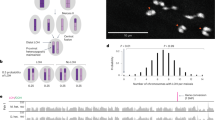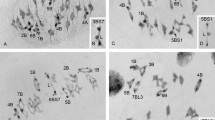Summary
Two two-point crosses in coupling alignement were made between intragenic suppressors at the locus b 2. The phenotype of the double mutant is distinguishable both from that of the wild type and of the single mutant. Thus one can select all kinds of recombination events.
The two crosses involve either two mutants which do not give postmeiotic segregation but which show opposite dissymetries in the direction of the conversion, or two mutants only one of which gives postmeiotic segregations.
The comparison of these crosses heterozygous for two mutant sites with crosses heterozygous for only one site makes it possible to draw the following conclusions:
-
1.
The basic conversion frequencies of either site are not modified by the presence of the other heterozygote site.
-
2.
Mutant sites in the heterozygous state may have a reciprocal influence on each other's conversion spectrum.
-
3.
When a mutant does not produce postmeiotic segregations, these are never induced by the presence of another heterozygous site. On the contrary, one heterozygous site may cause a decrease in the frequency of postmeiotic segregations for another site.
-
4.
Aberrant 4m:4wt segregations were observed only for the site which otherwise gives 5m:3wt and 3m:5wt segregations.
-
5.
In the cross which associates two mutants only one of which gives postmeiotic segregation, the modification of this dissymetry is effected in the same way regardless of the type of segregation. Among the double site conversion the extent of the modification of the dissymetry of the meiotic segregations is the same as that of the postmeiotic segregations.
The existence of a process which acts equally on meiotic and postmeiotic segregations implies that there is a common initial phase on which the process regulating segregation acts directly.
These data are discussed both in the hypothesis which involves the formation of a 3-stranded region of D.N.A. as the preliminary step in gene conversion and in the hypothesis involving the formation of an heteroduplex D.N.A. region followed by correction. Only the hypothesis implicating an heteroduplex D.N.A. region as the origin of conversion accounts for all the data.
In this hypothesis the data suggest that:
-
1.
Hybrid D.N.A. can not be regularly formed at a mutant site in one chromatid only.
-
2.
The correction is induced by the heterozygous site and not inhibited by it.
-
3.
The correction started at one site may frequently include the other.
-
4.
In the majority of cases, excision starts at either site but not at both.
-
5.
The facts are neither compatible with the idea of a polarized process of recognition of the mispairing along the heteroduplex nor with that of polarized excision.
Similar content being viewed by others
References
Boon, T., Zinder, N. D.: A mechanism for genetic recombination generating one parent and one recombinant. Proc. nat. Acad. Sci. (Wash.) 64, 573–577 (1969).
Fogel, S., Mortimer, R. K.: Informational transfer in meiotic gene conversion. Proc. nat. Acad. Sci. (Wash.) 62, 96–103 (1969).
Holliday, R.: Mutation and replication in Ustilago maydis. Genet. Res. 3, 472–486 (1962).
Holliday, R.: A mechanism for gene conversion in fungi. Genet. Res. 5, 282–304 (1964).
Hotchkiss, R. D.: Toward a general theory of genetic recombination in D.N.A. Advanc. Genet. 16, 325–348 (1971).
Kitani, Y., Olive, L. S.: Genetics of Sordaria fimicola. VI. Gene conversion at the G locus in mutant x wild type crosses. Genetics 57, 767–782 (1967).
Kitani, Y., Olive, L. S.: Genetics of Sordaria fimicola. VIII. Gene conversion at the G locus in interallelic crosses. Genetics 62, 23–66 (1969).
Kitani, Y., Olive, L. S., El-Ani, A. S.: Genetics of Sordaria fimicola. V. Aberrant segregation at the G locus. Amer. J. Bot. 49, 697–706 (1962).
Leblon, G.: Influence de la nature des mutations sur le mécanisme de la conversion génique. Thesis, University of Paris (1971).
Leblon, G.: Mechanism of gene conversion in Ascocolus immersus, I. Existence of a correlation between the origin of mutants induced by different mutagens and their conversion spectrum. Molec. gen. Genet. 115, 36–48 (1972a).
Leblon, G.: Mechanism of gene conversion in Ascobolus immersus. II. The relationships between the genetic alterations in b 1 or b 2 mutants and their conversion spectrum. Molec. gen. Genet. 116, 322–335 (1972b).
Lissouba, P., Mousseau, J., Rizet, G., Rossignol, J. L.: Fine structure of genes in Ascobolus immersus. Advanc. Genet. 11, 343–380 (1962).
Paszewski, A.: Gene conversion: observations on the D.N.A. hybrid models. Genet. Res. 15, 55–64 (1970).
Rizet, G., Engelmann, N., Lefort, C., Lissouba, P., Mousseau, J.: Sur un Ascomycète interessant pour l'étude de certains aspects du problème de la structure du gène. C. R. Acad. Sci. (Paris) 270, 2050–2052 (1960).
Stadler, D. R., Towe, A. M.: Evidence for meiotic recombination in Ascobolus involving only one member of a tetrad. Genetics 68, 401–413 (1971).
Whitehouse, H. L. K.: A theory of a crossing-over by means of hybrid deoxyribonucleic acid. Nature (Lond.) 199, 1034–1040 (1963).
Whitehouse, H. L. K.: Secondary crossing-over. Nature (Lond.) 215, 1352–1359 (1967).
Yu-Sun, C.: Nutritional studies of Ascobolus immersus. Amer. J. Bot. 51, 231–237 (1964).
Author information
Authors and Affiliations
Additional information
Communicated by W. Gajewski
Rights and permissions
About this article
Cite this article
Leblon, G., Rossignol, J.L. Mechanism of gene conversion in Ascobolus immersus . Molec. Gen. Genet. 122, 165–182 (1973). https://doi.org/10.1007/BF00435189
Received:
Issue Date:
DOI: https://doi.org/10.1007/BF00435189




